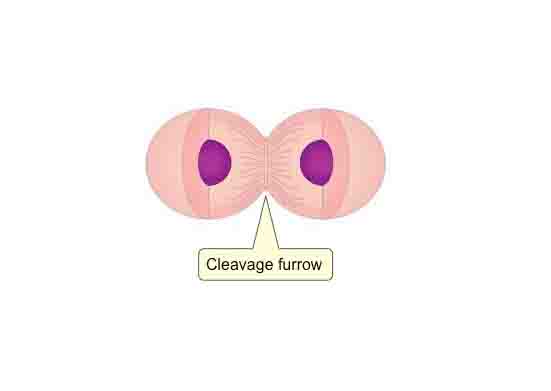Cleavage Furrow Definition
A cleavage furrow is an indentation that appears in a cell’s surface when the cell is preparing to divide. It marks the beginning of the cell’s “pinching” its cell membrane and cytoplasm down the middle. Eventually, the cell will pinch itself completely in two, forming two daughter cells.
This furrow is created by the same proteins that allow muscle cells to contract: actin and myosin. These proteins, which have the ability to expand or contract, form a “contractile ring” that begins squeezing the cell along its middle.
The squeezing creates a drawstring effect, by this contractile ring until the opposite ends of the ring meet in the middle of the cell. At this point, the cell membrane fuses shut on either side of the contractile ring – creating the membranes of two new and independent cells.
Cleavage furrows are primarily found in animal cells and some algal cells. Plant cells, which have stiff, inflexible cell walls that cannot be easily bent or “pinched,” use a cell plate instead.
The cell plate grows a new cell wall from the middle of the cell outward to touch the edges, instead of pinching the cell membrane inward until it meets in the middle.
Function of Cleavage Furrow
Cells reproduce by splitting in two. After successful cellular reproduction, each half of the parent cell becomes a new, independent cell. This “daughter cell” can then grow and divide itself, and this “cell cycle” continues infinitely, or until the cell population becomes too dense.
Cells must undergo many steps to reproduce successfully. Within the cell, DNA and essential organelles must be copied and then equally distributed to the opposite sides of the cell’s cytoplasm that will become its two daughter cells.
Once all of its components have been copied and distributed so that two healthy daughter cells will be produced, the cell must actually divide in two.
Animal and algal cells, like most cells, have a complex network of proteins called a “cytoskeleton,” which controls the shape of the cell. The cytoskeleton includes motor proteins, such as actin and myosin, which can expand or contract to change the cell’s shape.
The cell’s cytoskeleton is called upon when a cell has to change shape. This may be required when a cell wants to form a vesicle from its cell membrane, such as to ingest or excrete a substance. It is also called upon when the cell needs to reproduce by dividing in two.
Related Biology Terms
- Cell cycle – The cycle by which cells divide, grow, prepare to divide, and then repeat the process to perpetuate cellular life.
- Cytoskeleton – A network of proteins that are responsible for the shape of a cell.
- Mitosis – The process by which eukaryotic cells reproduce, by splitting into two identical daughter cells.

